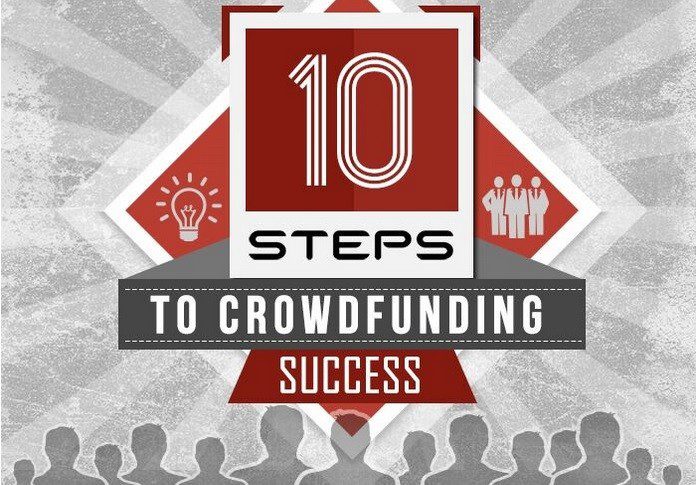There Is More to Crowdfunding Than People Realize
Many people who are new to the concept of crowdfunding are unaware of all the preparation that goes into a successful crowdfunding campaign and usually make the same mistakes that fall under one or more of the steps Illustrated below. They also tend to rush their idea onto a popular site without having a proper understanding of how it works and what motivates people to contribute to a rewards-based crowdfunding campaign. The goal of this article is to present a realistic view of rewards-based crowdfunding and the steps that need to be addressed in order to achieve success.
The Needle In The Haystack Syndrome
The first thing to understand is that the popular crowdfunding sites have hundreds of pages and host thousands of campaigns on any given day. It’s very easy to get lost on those sites and become a needle in a haystack, resulting in little visibility and support for your idea. Preparing a crowdfunding campaign takes time, effort and strategy, and it should not be done with limited knowledge or in haste.
The Numbers Are Not In Your Favor
The combined success rate of the two largest crowdfunding sites is slightly over 30%. This means that around 70% of the projects they host fail to fund. This is why you need to have every advantage on your side if you’re serious about using crowdfunding to launch your vision.
There are many more nuances involved in rewards-based crowdfunding but for the sake of brevity, I will not attempt to address them all right here. Also, all campaigns are unique and come with their own set of circumstances, so it’s not always one size fits all. Here are ten steps that just about all campaigns can benefit from.
1) Learn About Crowdfunding & Choose the Right Platform
There is voluminous amounts information on the web that can educate you on the subject of crowdfunding. Take some time to learn about it and all that’s involved in running a campaign to see if crowdfunding is right for you.
There’s really no way to write about crowdfunding platforms without mentioning Kickstarter and Indiegogo. They are by far the giants of the industry, but there are pros and cons to using those sites. There many other effective platforms to choose from that may be a better fit for you. Do your research and compare the different models, then you can make an informed decision when committing to the platform that will best suit your needs.
2) Define Your Idea & Goals
Define your idea and goal in clear, concise terms. Create a business plan or a well-thought-out strategy to penetrate the market you intend to enter. Having a good idea is one thing but it’s another proposition to implement a plan of action and see it through to its ultimate realization. A thorough business plan can be the best way to achieve a clear vision with an actionable strategy that will allow you move forward with unshakable confidence. You can use portions of your business plan in your presentation too, so it serves several purposes.
3) Scrutinize Your Idea
Start to expose your idea to people you know, which can be done in many ways. Social media is an easy way to reach a lot of people but you should also present your plan in person, to trusted acquaintances and start to gauge interest for your idea. Ask them to be brutally honest with you and try to find inconsistencies with your plan. During this step you can receive valuable feedback that can help you refine your concept and address any miscalculations made, before you go live. Your business plan can be updated as you go, so stay nimble in your thinking.
You should carefully consider feedback, but be sure to stay true to your vision. Don’t let negative feedback discourage you from following your dream if you truly believe in it. It should be noted that many crowdfunding campaigns (and business ideas for that matter) that seemed unconventional and deemed not viable in their early stages, went on to overfund by large multiples, so no-one ever knows how a campaign will do until it goes live.
4) Create Pre-Campaign Awareness and Support
Often overlooked, and one of the most important steps required to be put in motion before you start your campaign is to raise awareness and gather support for your idea. This can take anywhere from 1- 6 months, depending on the size and scope of your project, your networking skills and marketing abilities. If this step is missed or taken lightly, your campaign will have a far lower chance for success.
Studies have shown that almost all successful crowdfunding campaigns were initially funded between 20-35% through the project creators pre-campaign awareness efforts within the first two weeks of launch. Again, without this early support, your chance of success can drop drastically. Keep in mind, you will need this early support no-matter how popular the crowdfunding platform you choose. The first two weeks can make or break a campaign and usually sets the tone for the remainder. That’s why this step is so important.
An effective way to gain momentum is to find groups that may have a common interest in your projects completion and try to leverage their support. It’s important to promote your campaign outside of your network to organizations or bloggers and reach out to people who are also passionate about your project.
Rewards based crowdfunding, in most cases, is an exchange of goods and services; it’s not a charity, so don’t be shy, and be creative when seeking support. Get out of your comfort zone, be proud and loud and evangelize your message.
5) Use a Proven Strategy When Designing Your Campaign
During this step you should take some time to study other campaigns, successful and unsuccessful. Learn why some campaigns were successful and why some weren’t. What was it about these campaigns that made the crowd want to support them? There are thousands of campaigns at your fingertips and so much can be learned from this process alone.
Many campaigns touch the crowd at an emotional level, while others offer cool products and rewards, but the most successful ones do both. Another reason people contribute to campaigns is to be part of the creative experience, so include your supporters wherever you can. It’s important to determine what your project offers and then structure it accordingly.
Remember, don’t make your campaign about yourself. When telling your story, make sure you focus on what your project will do for others. Most people care more about their own needs or a cause rather than what your needs are, so don’t get hung up on you.
Related: Vision Launch Crowdfunding Resources & Tools
6) Make an Awesome Presentation
Your presentation to the crowd can make a huge difference in your results. Be sure to include as much visual imagery and information to illustrate what your project is about and how you will achieve your goal. By making the best presentation possible, you will demonstrate that you are professional and serious about your vision. If you have any manufacturing abilities to create your new product, show it, if you have prior projects or experience, show that too. People will need to trust and believe that you can do what you say you will. You will also want to get the crowd excited to be a part of your project and a strong presentation is a great way to do that.
7) Setting Your Funding Goal & Campaign Time-frame
It’s important to set a realistic funding goal that fits the size and scope of your project. When setting your goal, be sure to ask for only what you will need, but don’t shortchange your project either. Be sure to show your contributors what the money will be spent on in a budget overview. Transparency is an important element of crowdfunding.
Choosing a time-frame is a matter of preference, but most of the interest in successful campaigns happen within the first 30 days. Although it’s not always advertised, many crowdfunding platforms allow time extensions, especially if your campaign is popular, so depending on the site you choose, a minimum of 30 days and maximum of 60 days is a pretty safe range. After 60 days, interest is limited and 45 days is probably ideal for most campaigns.
8) Offer Desirable, Exciting Rewards and be Sure You Deliver
Rewards or perks are an essential part of rewards-based crowdfunding. You will be required to deliver these items to your contributors. The expenses for these items should be accounted for in your budget as well. This is how you thank your contributors for having faith in you and supporting your project. It’s important that you offer creative, exciting rewards in return for contributions. In many cases, involvement in your project in one form or another can be a very popular reward or perk. Remember, you will have to follow through on your commitments to your contributors, because if you don’t, it will hurt your reputation.
Many people confuse crowdfunding with charity, and while that may be true in some instances, it’s generally not the motivation by which people contribute to creative campaigns. In most cases, the success of your campaign will have a direct correlation with the rewards that are offered in exchange for contributions, so it’s very important to make them desirable with realistic price points.
9) Your Video
Make a short video that will best represent you, your team, and your idea. Your video allows the crowd to connect with you on a more personal level. Studies have shown that campaigns without videos have a lower chance of success. Your video does not have to be of the highest production value, it just has to effectively convey your idea to the crowd. With that being said, your video will be an important representation of your project, so it should be of decent quality. Be creative and have fun when making it, and be sure to keep it under five minutes (even less is better). Keep in mind, your video may be the only piece of your presentation that many people will take the time to engage in, so make it count.
10) Time to Launch
Prepare for launch: this is your chance to share your unique vision with the world! Once you launch you must dedicate time and energy every day your campaign is live. The crowd should be viewed as your partner in your new endeavor and be involved in every step of the process. Update them as often as you can, read their comments and interact with them during this phase.
Ultimately, the crowd will decide whether you are trustworthy and if your idea is one they wish to support. So put your best foot forward, be honest, transparent, and gain the crowds trust. Create a buzz and get the crowd excited to be involved in your campaign and support your vision.
Final Note
As in life, there is no guarantee of success in crowdfunding, and not every idea is going to resonate with the crowd, even if all the steps mentioned above are followed. However, by following these steps you will afford your idea the best opportunity for success. If these steps are ignored, or done half-heartedly, you will most likely fall into the 70% of campaigns that fail to get funded.
Strong proponent of individual liberty and free speech. My goal is to present information that expands our awareness of crucial issues and exposes the manufactured illusion of freedom that we are sold in America. Question everything because nothing is what it seems.


















